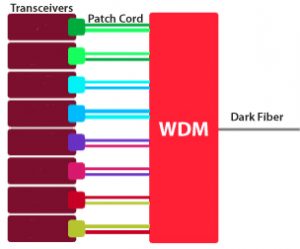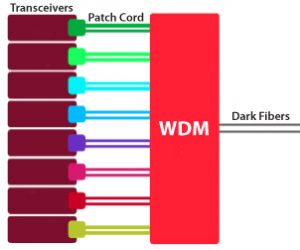First off, what is Wave Division Multiplexing?
Wave Division Multiplexing, better known as ‘WDM‘, is a method of combining or separating multiple wavelengths of light in or out of a single strand of fiber with each wavelength of light carrying a different signal, like a voice signal, video signal and/or data signal. The use of optical filters allows a certain range of wavelengths and lets another range of wavelengths pass through. Using a WDM in your network is a cost effective way to increase the capacity of a network.
Without a WDM, a single fiber would be dedicated to each customer’s voice, video or data device from the headend, or originating source, to the end user. This would account for a lot of fiber and potentially a lot of extra expense.

Multiple fibers from the headend to the end user – that’s a lot of fiber!
The foundation of WDM lies in the ability to send different data types over fiber networks in the form of light. By allowing different light channels, each with a unique wavelength, to be sent simultaneously over an optical fiber network a single virtual fiber network is created. Instead of using multiple fibers for each and every service (as above), a single fiber can be shared for several services (as below).

The WDM gathers all data streams together to be transported simultaneously over a single fiber.
With a WDM, a single fiber is used from the headend, or originating source, to the end user. Within that single fiber are varying wavelengths that handle all of the voice, video and data usage.
There are two different types of WDMs:
- Coarse Wave Division Multiplexing or CWDM: CWDM is standardized to have 18 different wavelength channels with a spacing of 20 nanometers (nm) starting at 1270nm and ending at 1610nm. Most systems use the eight channels in the upper band (eight channels from 1470nm to 1610nm). The advantage of CWDM systems is that it is always possible to upgrade at a later point in time to limit the installation cost on day one. The wider channel spacing places less stringent requirements on the lasers, which allows use of less expensive lasers without temperature controllers.
- Dense Wave Division Multiplexing or DWDM: DWDM devices are mostly used in the core networks to extend over very long distances and where more wavelengths are required between sites. The 16-40 wavelength channels are distributed in the C-band from 1530nm to 1570nm. If required, DWDM can be “over-layed” on a CWDM infrastructure to increase capacity further. Multicom’s MUL-DWDM-RM-D-16C2136 is a good example of DWDM that multiplexes 16 Channels (CH21 to CH36) over one fiber.
Typically CWDM and DWDM have lower insertion losses compared to the use of optical splitters. This significantly increases the reach of the network from the central office. Moreover, every customer has an assigned wavelength(s), providing greater security and making eavesdropping difficult if not impossible.
One Fiber vs. Two Fibers
The upstream and downstream signals can be sent through the same fiber at different wavelengths or on two separate fibers. Most CWDM systems are built as two-fiber systems where one fiber is used for the upstream and the other fiber is used for the downstream. In that case, each customer has two separate fibers and one wavelength. If only one fiber is used, every customer will have two separate wavelengths.

Bi-directional Transceivers used to transmit and receive data over a single fiber

Fiber pair used to transmit and receive data on different fibers
Passive Optical Components can have a significant impact on the efficiency of communication network roll-outs. The incorporation of passive WDM devices reduces the amount of fibers in the network, decreasing both the footprint and investment cost of network roll-outs. In existing networks, these components allow capacity upgrades at a relatively low cost without additional construction works.
- Transceivers are wavelength-specific lasers that convert data signals to optical signals that can be transmitted into the fiber
- The Patch Cord or ‘Jumper’ connects the output of the transceiver to the input on the WDM
